Felix and Mylo: the first 6 months
10 May 2024
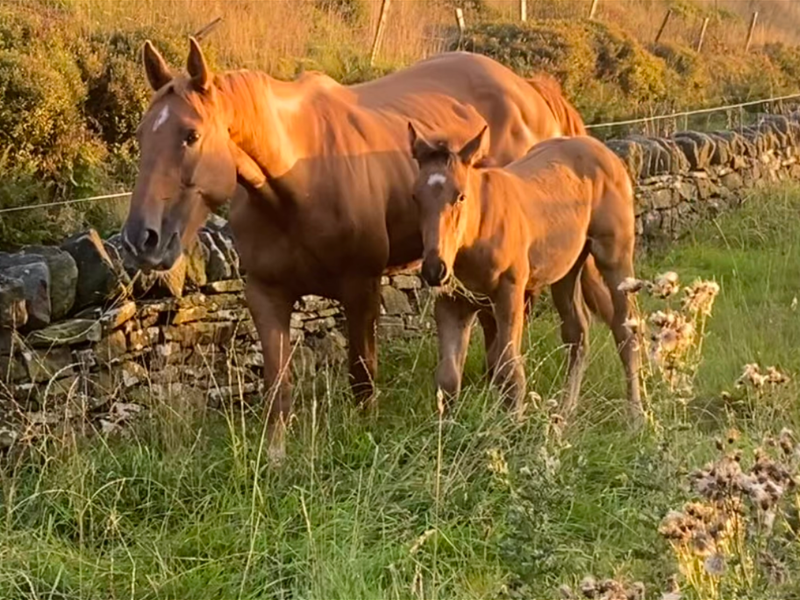
The priority for babies is to be healthy and happy in body, mind and soul. Felix and Mylo were both turned out 24/7 with Amber on mixed grazing and on a hillside.
They lived mainly on Dr Green: we had access to well rested fields, bounded by hedges and trees, where they were able to graze and forage. Not to mention shelter from the Derbyshire weather! Both wintered out un-rugged perfectly happily.
The hills and 24/7 turn out helps build a strong musculoskeletal system – essential for their future ridden careers. It also builds sure footedness, proprioception and balance. Though watching them hurtle down steep hills, turn on a six-pence and fly back up again was heart-stopping at times!
As Myka starts her journey to being a ridden horse, this quote reminds me of the importance of solid foundations and patience. I am grateful for a horse with a sound, strong, healthy body and a calm, willing mind. I am totally committed to helping her confidently stand and walk and run and dance before we start to fly. Myka is now nearly 4 and her groundwork is coming along beautifully. She is soft, light, relaxed. So the next step was..... to get on. But as she's a very sensitive horse, I did not want to risk messing it up, so Joe is going to start her for me. She has been dropped off with him, and I can't wait to see her progress over the next few weeks.
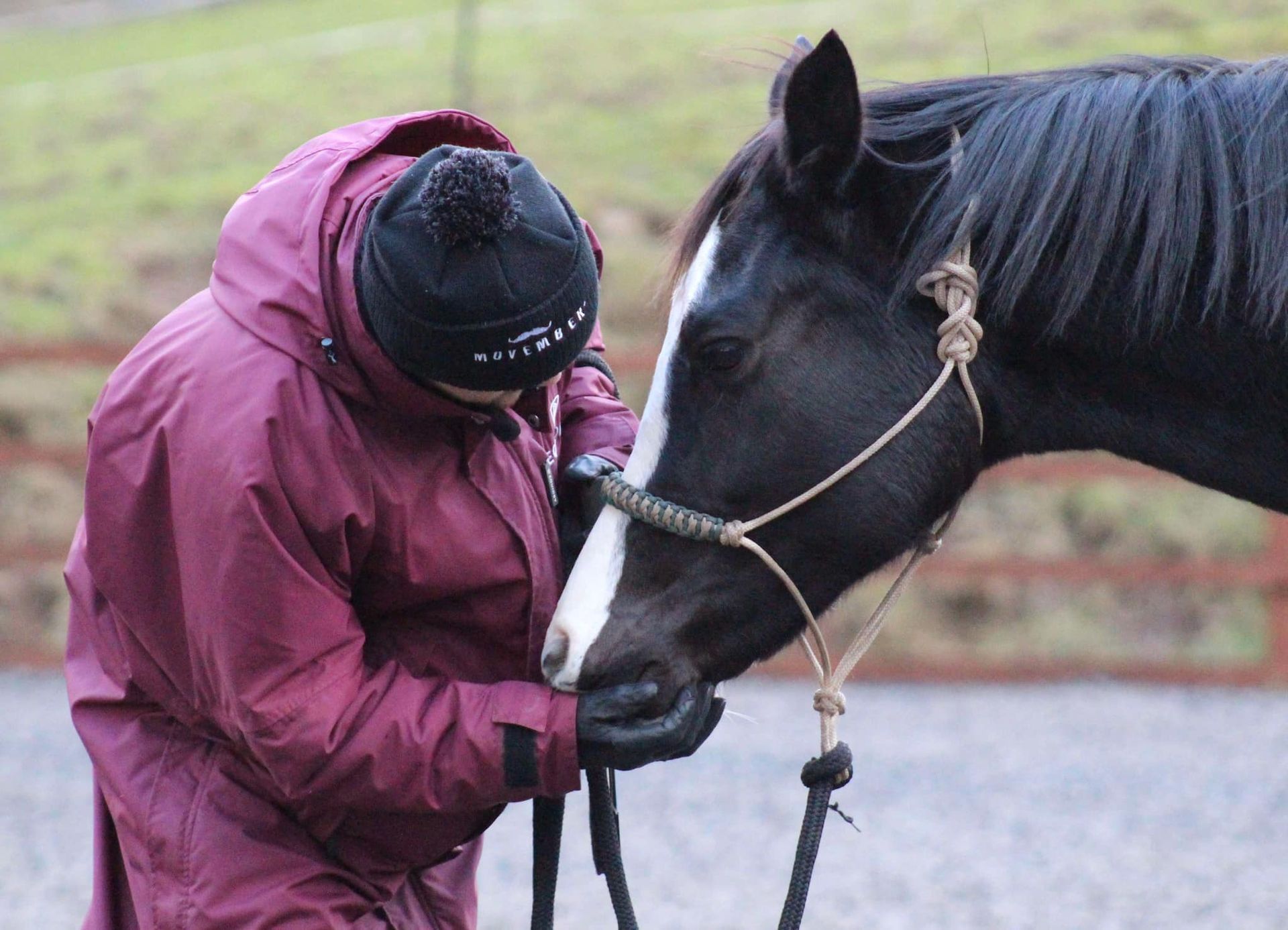
Myka showed off her funky moves occasionally, but most of the time was focused and tried hard. I’ve said it before, but Joe is a genius! He was able to see tension in Myka, that I was completely oblivious to, because she was responsive and obedient. He took over and identified what she was worried about very quickly then, for a while, it all got a bit more lively as he worked through her worries. But by the end she was much calmer with more clarity. She was far more worried about the flag than I had realised because she stood still to it and did not overreact when I used it, but things like flared ribs, breathing, diaphragm movement etc showed him the areas where she was still wary. And though her eruptions are often triggered by stuff outside the arena, even in the arena she is too close to threshold too much of the time. So we are not going from calm to spooky but from just about coping to not coping. He took her and did the same movement patterns I had done, and he said that while what she did looked almost identical, how she felt while doing it was very different. So that was really useful to know. His overall verdict is that a significant proportion of her dramatics would disappear with more of the work we were doing today, particularly with the flag. He felt that at the beginning of the lesson any attempt to get on her would end badly and quickly, whereas by the end, she was a lot closer to being ready. Can't wait to be onboard!! But she'll be ready when she's ready. There is no rush.
Funny how things turn out. Legrande was the stallion I chose for Amber. She went there to be covered and Mylo was conceived there. A few weeks ago Myka appeared on the Legrande stud page as her owner planned to start her education. Lottie had just been retired. A friend said to another friend: ‘AE is going to buy that horse’ before I even knew she existed. After Lottie had to retire I new I wamted a new horse, and that Mylo was a bit too far off being ready to back for me to want to wait. But that I could not afford a ready-made horse. So I posted on FB wanting breeder/producer recommendations, and Legrande's owner contacted me Myka. I went to view, fell in love and decided she was coming home with me. I only found out about my friend's prediction after I had bought her In the meantime I was looking for somewhere for Mylo to go as his current companion is 30 and I think he needs younger playmates. Turns out they do youngstock livery too. So today I dropped off Mylo and picked up Myka. Mylo met his dad, said hi to his sister, and I brought Myka home. I can’t believe these 2 utterly gorgeous horses are mine. Feeling very lucky.
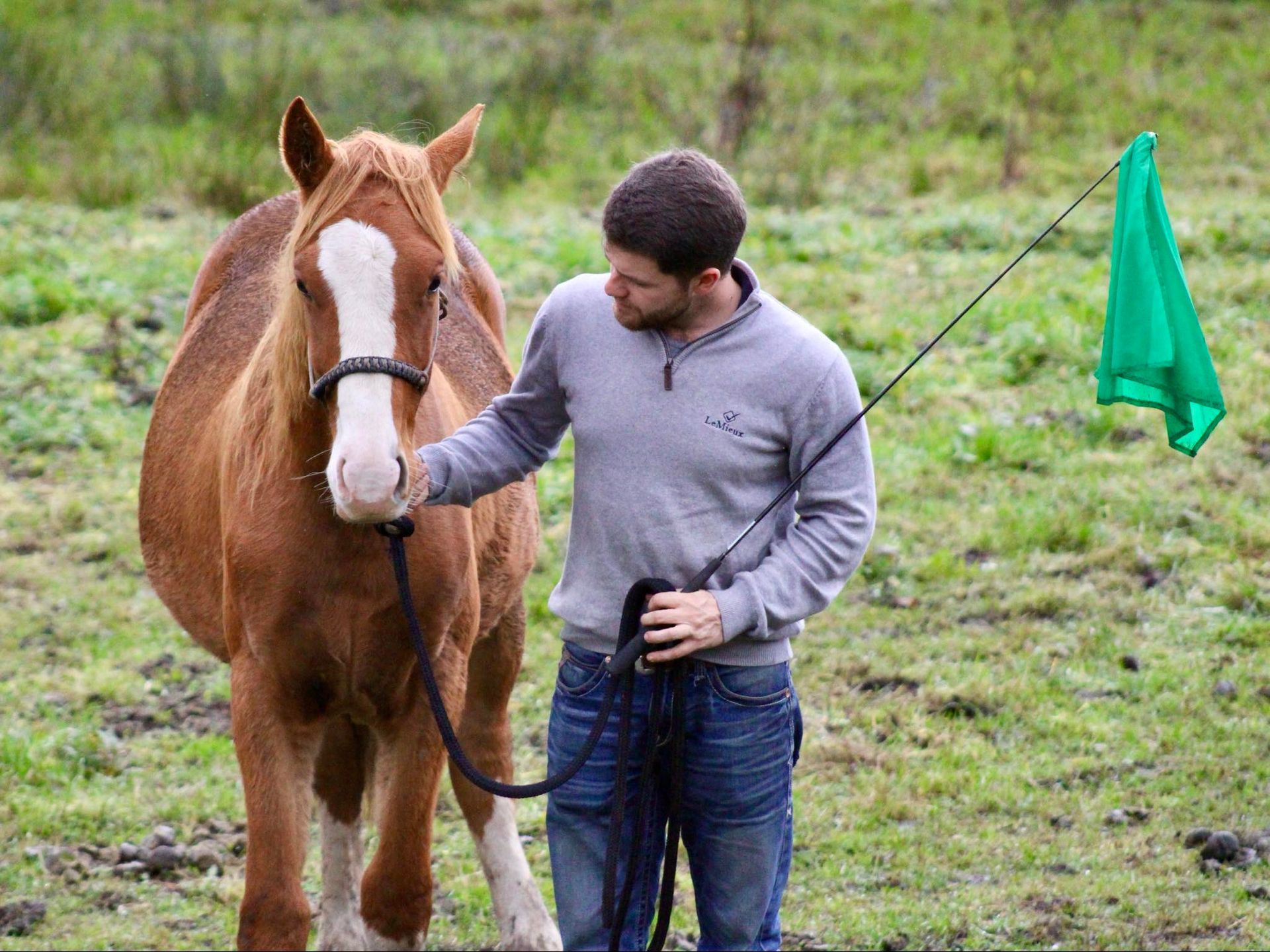
My aim for Mylo was to instill some very basic foundational skills that will make life for us both so much easier when he comes to be a ridden horse. Trust and connection mean more than just having a good relationship with your horse: it also refers to attunement and clarity of communication, to boundaries, to the horse being mentally and emotionally 'with you'. So there are the WHAT skills - what the horse can do. And the HOW skills - the quality with which the horse does it. Mylo's WHAT skills were reasonably solid - he leads, he yields, he flexes, he backs up, he is gentle to touch all over and comfortable with my training tools. But at the last Joe lesson, we had to work on HOW skills - he was doing the 'right' thing through memory, not by carefully watching for instructions and working things out in the moment. Joe demonstated this by mixing things up a lot more - working on back up for a while and then moving off, with Mylo expected to follow. He got his feet a bit stuck because his mind was still on back-up. Showing that his leading skills were based on expectation and memory - when Krissie does X I am expected to follow her around the field - and not on him taking cues from me moment by moment. That level of subtlety blows my mind! But we worked on it a bit and the next day I put him to the test as we had to load him as he is moving to young-stock livery. He has not been trained to load. The inital plan was to follow his field mate on. But I was curious as to whether he could follow instructions and work it out. And, bless him, he did. He loaded easily and comfortably with no specific loading training. Just trust and communication. He is now off to join his siblings at the stud where he was conceived till he is 2. Joe assures me he has all he needs till his starts more formal training. And so now he is going to go away and grow up. I'm going to miss him, but I think being in a herd of youngsters will be really good for him.
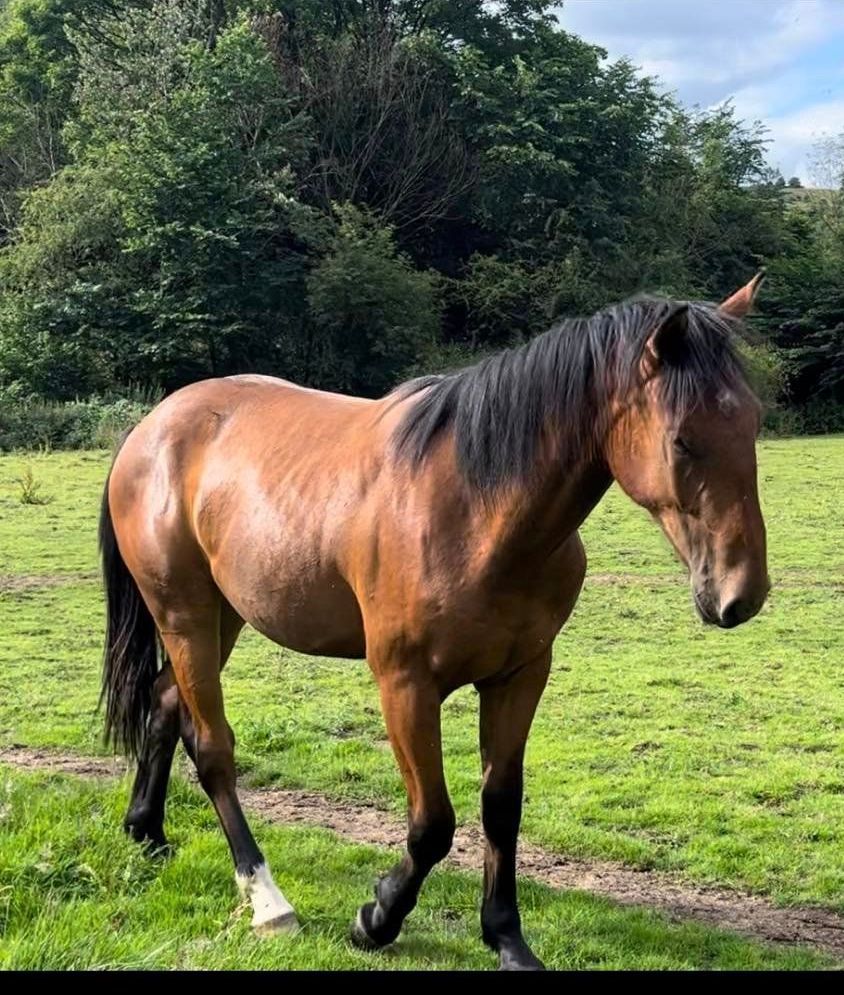
Felix has had fairly minimal training up till now. The focus has been on physical and psychological health and well being. Friends, freedom and forage – living out 24/7 on a hillside with pals. He was handled regularly to ensure he was comfortable with the many things he has to put up with that go totally against his instincts: being stabled, being led by the head and restrained, having a leg picked up – thereby impeding the ability to run, being touched all over his body. He proved to be totally unflappable, accepting weird and wonderful human behaviours placidly, pretty much from day 1. This is great as a sign that he will be trainable, and a steady, safe, chilled horse. But does not come without issues…. A lot of training is based on the idea that a horses move each other around using energy/intent and gesture before they go in with teeth and hooves. And we can use that too – so-called ‘pressure-release’. We ask the horse to move from body language, or a raised flag, and the more reactive a horse is, the more sensitive they are to those pre-physical cues. Felix, on the other hand, is very laid back and calm, which means generating usable energy is not always easy. He's definitely more woah than go. But I'd like him calm and responsive as opposed to calm and dull. In watching me work Felix, our trainer, Joe Midgley, observes that I have a tendency to nag him with the flag to keep him going. Under saddle that looks like kick...kick...kick which we absolutely don't want. And also that unlike with Lottie I don't really use energy cues, because he appears largely oblivious to them. BUT, if you go straight in with a physical aid you will ALWAYS need a physical aid. If I want him to be soft and to respond to subtlety, I need to start as soft as I'd like it to be in the end, build stepwise, and slowly he will sharpen up to the subtler cues. Doing this on the ground first creates the template in his mind that cues starts soft and build. This basic principle will be used in 1000 different ways throughout his handling and ridden life. Felix starts to move but quits again quite quickly. I have a tendency to anticipate that and so raise the flag again to keep him going. This will train him to need constant nagging to keep going. I need to let him make the mistake (slow down or stop) then correct it, rather than try to pre-empt. The key in all this is that I am working with his mind – I’m teaching him how to respond to cues: ie softly, and then also to maintain what has been asked for independently till I ask for something else. So that when he comes to be ridden, his ‘template’ for instructions is already clear: he understands that he is to respond immediately to soft cues, then to maintain without the need for nagging. And the payoff for him in all that is that there is no real pressure – just communication. The flag (or leg or hand) act as a signal, not an accelerator or brake. Plus this way of communicating makes intuitive sense to a horse as this is what they do to each other. A dominant mare might progress from an ear flick, to a look, to a fixed stare, to pinned ears. And finally to a lunge with teeth or a double barrel. Horses get this and don’t take offence. It also generally never gets to teeth and hooves. The human equivalent to the above looks something like: energy/intent, body language, raise flag, flap the flag, then tap with flag, get big and drive with the flag. I like the flag because it is a soft piece of cloth – you can’t hurt the horse with it, but it is visually very clear to the horse. By the end of a session with Joe Felix was moving off the raising of the flag and no longer needed flap or tap. And although he still slowed down pretty quickly, he was maintaining for a bit longer before before doing so. Progress…..

After weaning, Felix and Mylo were turned out with other youngsters. My aim for them at this early stage of their life was ‘feral but friendly’. And they were both certainly that! They were curious, affectionate and totally unafraid of people. They both loved a scratch and groom, and were good for the farrier. They accepted a halter willingly, even though they had no idea at this early stage how to give to any pressure or follow a feel. The focus remained building healthy bones, joints through 24/7 turnout, access to mixed grazing (supplemented very slightly in winter for minerals and protein) and to stay relaxed and happy with friends.

A real head turner, Mylo is chestnut with a white face and 4 long white socks. The name was initially just a temporary joke name. But it grew on him. His damsire is Beachball (OBOS Quality X Echo Beach) and he is bright orange, like the cocktail. He is by Legrande: a versatile, athletic warmblood who has competed at FEI levels in all 3 disciplines. Mylo is performance bred with the hope that I can ride him, but if not I will happily pass the reins to someone more capable and enjoy an ‘owned by, ridden by’ relationship with him.
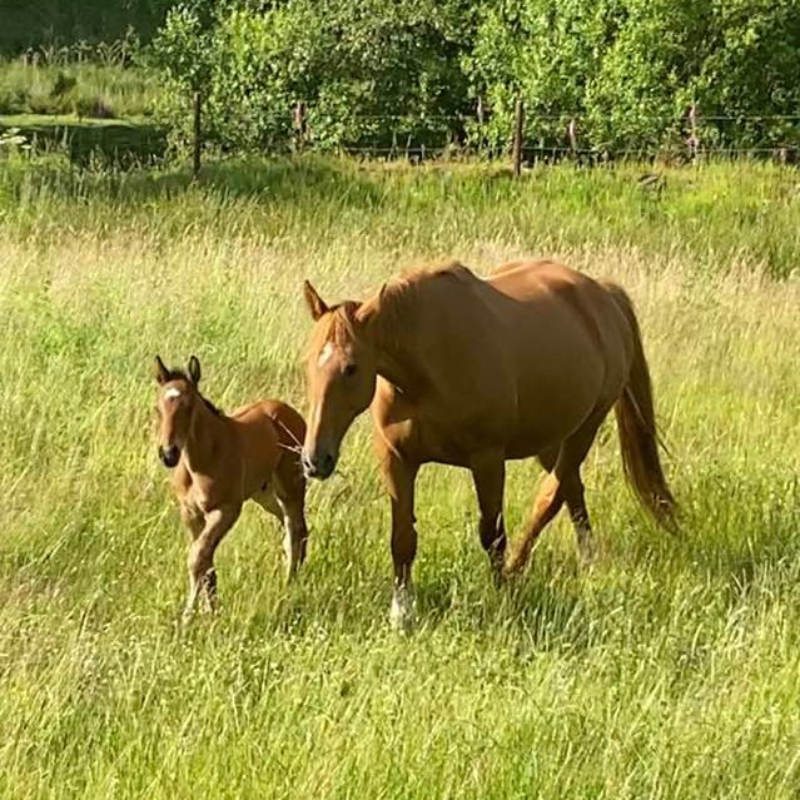
Little Felix could not work out how to suckle at first and needed help from the vet. Hence his name – he needed some Liquid and we needed some Luck! But once he was up and began to feed, he rallied rapidly and from then on was fine. He is by a Class 1 RID (Ebony Duke) out my ISH mare, Amber, who has OBOS Quality/Echo Beach/Classic Vision lines. The RID genes should add calmness to Amber’s pretty full-on temperament!

